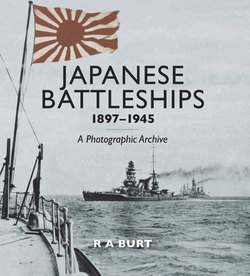Читать книгу Japanese Battleships, 1897?1945 - R. A. Burt - Страница 10
ОглавлениеDisplacement: 14,850 tons normal load
Dimensions: Length: 438ft oa; Beam: 75ft 6in (Shikishima), 76ft 9in (Hatsuse); Draught: 27ft 6in mean
Armament: 4 × 12in; 14 × 6in; 20 × 12pdr; 8 × 3pdr; TT: 4 × 18in (Shikishima); 5 × 1 8in (Hatsuse)
Armour: Main belt: 9in (Harvey); Barbettes: 14in; Turrets: 6in; Casemates: 6in; Decks: 4in–1in; Conning tower: 14in
Machinery: Two sets three-cylinder, triple-expansion engines driving two screws, twenty-five Belleville boilers with economisers
Designed SHP: 14,500 (forced draught) for 18 knots
Fuel: 700 tons coal normal, 1,400 tons max
Complement: 741
Laid down: January 1897, Thames Ironworks, Blackwall
Launched: 1 November 1898
Completed: January 1900
Fate: Scrapped, 1948
Laid down: 1897, Armstrong’s, Newcastle
Launched: 27 June 1899
Completed: January 1901
Fate: Struck Russian mine and sank 15 May 1904
Shikishima approaching Portsmouth shortly after completion 1 January 1900
Determined to build up their battle fleet, the Japanese placed repeat orders with the same two firms after Fuji and Yashima had been completed. Shikishima and Hatsuse were laid down in 1897. Based on the success of the British HMS Majestic, the new ships reflected many similar features, although on completion they were often compared with the newer Formidable-class.
Shikishima at anchor in Malta February 1900
Carrying out her full-power trials in September 1899 she attained a speed of 19.027 knots, remarkably fast for her day. She had a long and interesting career, and was in action many times during the Russo-Japanese War. She was hit in the funnels and stern (suffering sixteen casualties) at the battle of Port Arthur, 9 February 1904 and was again in action off Port Arthur on 24 February. She was also present at the battle of Tsushima on 27–29 May 1905 (suffering thirty-seven killed). Reduced to a coastal defence ship in September 1921, she was used for training purposes before being hulked as a transport ship during the spring of 1923.
Shikishima
After the Russo-Japanese War it was obvious that good battle practice was essential to attain adequate gunnery performance, especially at long ranges (during the war battles had been opened with salvoes fired at distances of up to 10,000 yards which was very unusual at that time). The Japanese put their war experience to good use and carried out frequent manoeuvres and constant battle and gunnery training. This photograph is stated to be Shikishima and the Japanese battle fleet going into action at the Battle of the Yellow Sea on 10 August 1904.
Hatsuse as completed before leaving for Japan 1901
An identical sister-ship to Shikishima, it was exceptionally difficult to tell one from the other. Two points to help in identification, however, were the portholes near the anchor beds and the lower yards on the fore and mainmasts which were positioned higher in Hatsuse.
